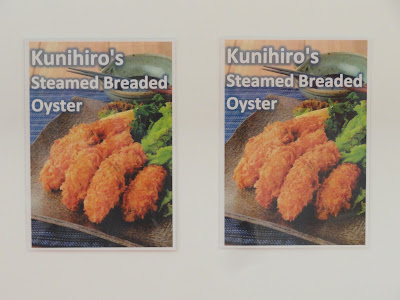--Jean-Paul Aron
It is no secret that Japan is a country that loves and admires seafood. Seafood is essential to their cuisine and approximately 80% of the seafood they consume derives from 18 different species. In comparison, 90% of the seafood consumed in the U.S. comes from only 10 types of seafood. Once again, the Japanese Pavilion at the International Boston Seafood Show presented numerous unique and tasty treats and I wanted to collect them together into a single post. Besides their booths, they also ran a series of small cooking demonstrations, showcasing their foods and recipes.
S. Marche Co., Ltd has a fish farm in Kagoshima where they breed Yellowtails, which are also known as Hamachi or Buri. Sometimes those terms are used to specify the size of the Yellowtail, such as Hamachi being under 80cm and Buri being over 80cm. The Yellowtails that S. Marche raises are not given any antibiotics and curiously, kurozu, black vinegar, is added to their feed and it is supposed to make them healthy. As kurozu ferments for a longer period than regular vinegar, it is thought to contain more healthful nutrients. They sell several different Yellowtail products include a Yellowtail Fillet, Yellowtail Teriyaki, Zukedon of Yellowtail (which is suitable for rice bowls), and Mago-Chazuke of Yellowtail (which is sesame flavored). The Yellowtail is very tasty, with a firm consistency, a smooth texture in the mouth and a pleasant, mild taste.
Last year, I gave kudos to Ahjikan Co, Ltd. for their Sushi Tamago, which is said to be the number one in the U.S. market. When I order sushi, I usually add an order of tamago as I enjoy its slightly sweet taste but not all tamago is the same. Some is thin and almost too watery, while some is too thick and tough. Ahjikan though produces an excellent tamago which possesses the proper balance of texture and moistness, and has a rich, eggy flavor with a hint of sweetness. Yum.
Kunihiro Inc. exports seafood, mainly oysters, from the Seto Inland Sea, around Hiroshima. They use state of the art technology to process their oysters, ensuring they are safe of any toxins, bacteria or viruses. This technology also succeeds in sealing in the umami though the items are frozen. They sell a variety of oysters products, such as Frozen Oyster Meat, Sushi Oyster Meat, and Sakura Smoked Oyster Meat. to the world.
I attended a demonstration of their Fried Breaded Oysters which was also educational. For example, oysters are sometimes known as the "milk of the sea." In addition, the Japanese advise that you should eat three oysters a day for your good health. The fried oysters were delicious, with a crisp, crunchy coating and juicy oyster meat inside.
The longest line at the Japanese Pavilion was at the Rumi Japan (Morimatsu Suisan Reito Co., Ltd.) booth. The company is located in Shikoku, facing the Kurushima Strait in the center of the Seto Inland Sea. They have been a seafood wholesaler for over forty years and now are also a seafood processor. Their products include a variety of fresh and frozen fish, as well as some processed foods like rice cakes.
What were so many people waiting in line to taste? Yellowtail nigiri. Rumi Japan uses a special technique, called Ikijime, to prepare their Yellowtail. This is a nerve-removal processing where the head and gut are removed and cut into three pieces. The bones are then removed so only the meat remains and this is supposed to preserve freshness for a very long time. I don't know how long this Yellowtail will remain fresh, but I am sure that it is absolutely delicious. It is tender and flavorful, a fine piece of sushi. I have devoured several pieces of this Yellowtail over the last couple days. And everyone else that I know who has tasted it, has really enjoyed it.
Daiei Foods Co., Ltd., located in Kanagawa, was founded in 1973 as a food processor company. They produce a variety of seafood products, from salads to raw fish. I got a chance to try their Tobiko, a frozen, seasoned flying fish roe. What a beautiful orange color! And it was tasty, with a crunchy texture and a mild brininess. This would be great for using with sushi.
The origins of Futaba Co., Ltd. extend back to 1948 and then are now a producer of Dashi, a type of broth or soup. It is the foundation of Japanese cuisine and is the basic component of many of their dishes. Futuba currently makes over 300 Dashi products,
Chef Akira Inoue, pictured above, introduced me to three of their liquid seasonings, versatile liquids which can be used, in varied proportions, to make many different dishes. The Don Don Series Katsuo-Tsuyu is a basic Dashi stock which can be used to make soups though it can also be added to noodle dishes, rice bowls and more. The Don Don Series Shiro-Tsuyu is also a Dashi stock but it also contains a special white soy sauce. It too can be used in soups and many other Japanese dishes. Finally, I tried the Don Don Series Kappou-Dashi is a different type of Dashi stock, made with shaved bonito. I tasted all three and each was rich in umami with very pleasant flavors. I got to try a mushroom soup made with one of these liquids and it too was flavorful and rich in umami. These are easy to use, and you can avoid having to prepare your own dashi stock.
They also produce a Fish Jerky, made from thick, shaved bonito chips without any additives. To prepare them, you just pop them into a microwave for about one minute to make them crispy. They were crispy, like a thin bacon, with a mild fish taste. They would make for a cool snack, especially with a glass of Sake.















No comments:
Post a Comment